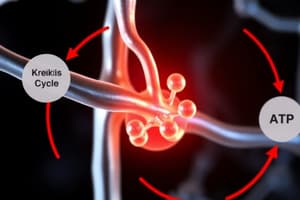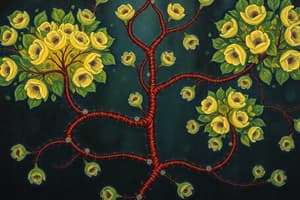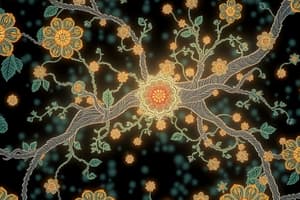Podcast
Questions and Answers
In which cellular compartment does glycolysis occur?
In which cellular compartment does glycolysis occur?
- Outer Mitochondrial Membrane
- Mitochondrial Matrix
- Inner Mitochondrial Membrane
- Cytoplasm (correct)
What is the net gain of ATP produced during glycolysis?
What is the net gain of ATP produced during glycolysis?
- 4 ATP
- 38 ATP
- 36 ATP
- 2 ATP (correct)
Which molecule is produced in the bridge reaction that links glycolysis to the Krebs cycle?
Which molecule is produced in the bridge reaction that links glycolysis to the Krebs cycle?
- ATP
- Glucose
- Acetyl CoA (correct)
- Pyruvate
What is the primary function of the electron transport chain in cellular respiration?
What is the primary function of the electron transport chain in cellular respiration?
Which of the following processes is NOT directly involved in ATP production?
Which of the following processes is NOT directly involved in ATP production?
Flashcards
Glycolysis
Glycolysis
The first stage of cellular respiration; anaerobic process in the cytoplasm that converts glucose into 2 pyruvate.
Bridge Reactions
Bridge Reactions
Conversion of pyruvate to Acetyl CoA, releasing CO2 and producing 2 NADH as pyruvate enters the mitochondria.
Krebs Cycle
Krebs Cycle
Also known as the Citric Acid Cycle; an aerobic process in the mitochondrial matrix that processes Acetyl CoA, producing ATP, NADH, FADH2, and CO2.
Electron Transport Chain
Electron Transport Chain
Signup and view all the flashcards
Chemiosmosis
Chemiosmosis
Signup and view all the flashcards
Study Notes
Cellular Respiration
- Glycolysis (anaerobic): Occurs in cytoplasm. Glucose is converted to 2 pyruvate. Net gain of 2 ATP and 2 NADH.
- Bridge Reactions: Pyruvate is transported to mitochondria. Pyruvate is converted to Acetyl CoA. CO2 is released and 1 NADH is produced.
- Krebs Cycle (Citric Acid Cycle, aerobic): Occurs in mitochondrial matrix. Acetyl CoA enters the cycle. Net gain of 2 ATP, 6 NADH, and 2 FADH2. CO2 is released.
- Electron Transport Chain & Chemiosmosis (aerobic): Occurs in the inner mitochondrial membrane. Electrons from NADH and FADH2 are passed through proteins, releasing energy. This energy is used to pump H+ ions across the membrane, creating a gradient. H+ ions flow back across the membrane through ATP synthase, generating ATP. Oxygen is the final electron acceptor, forming water (H₂O). Net yield of approximately 32-34 ATP.
Studying That Suits You
Use AI to generate personalized quizzes and flashcards to suit your learning preferences.




